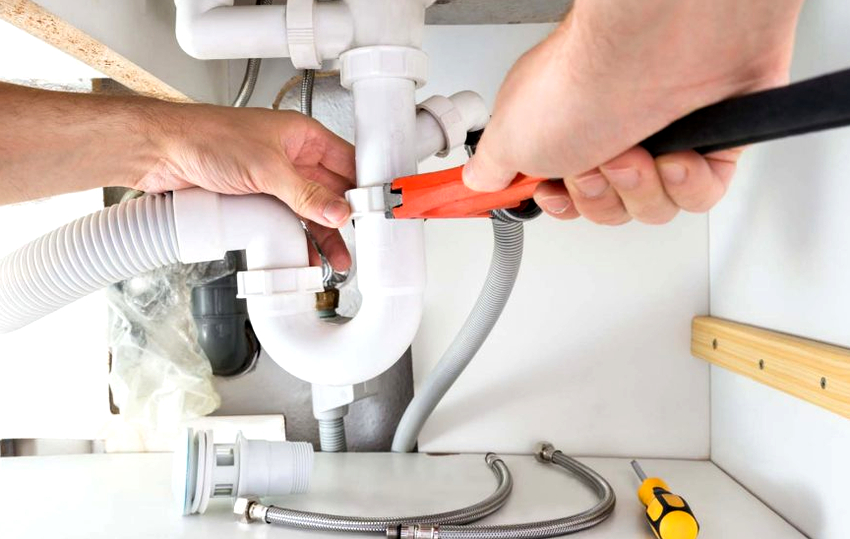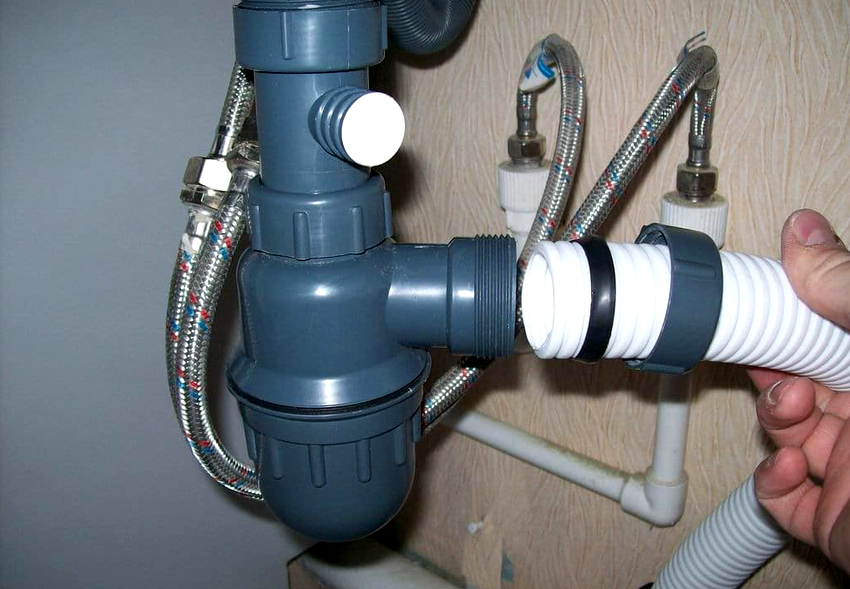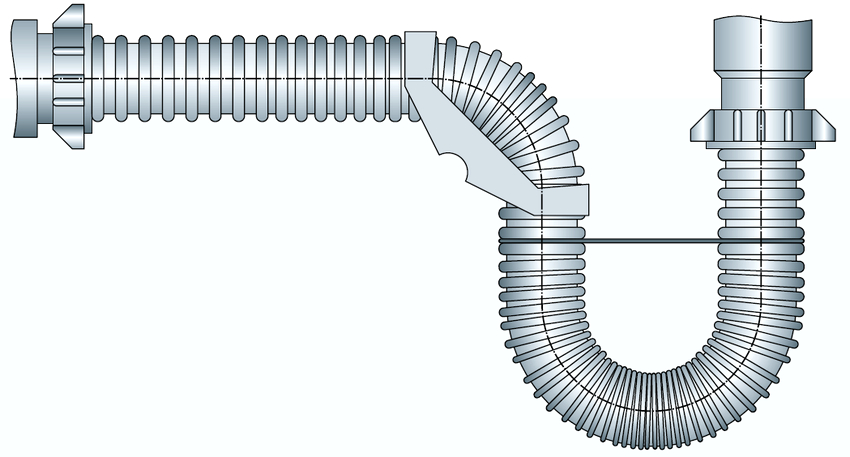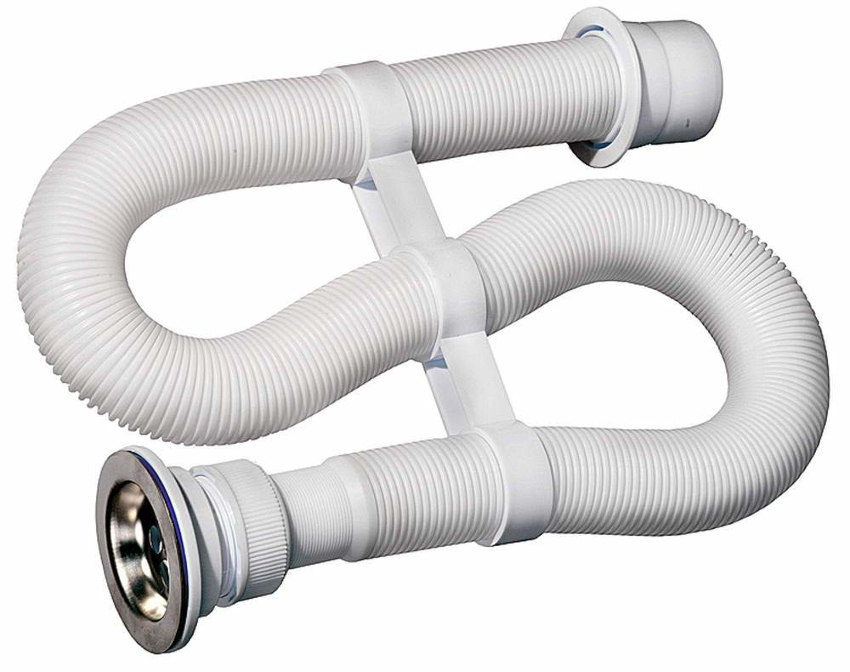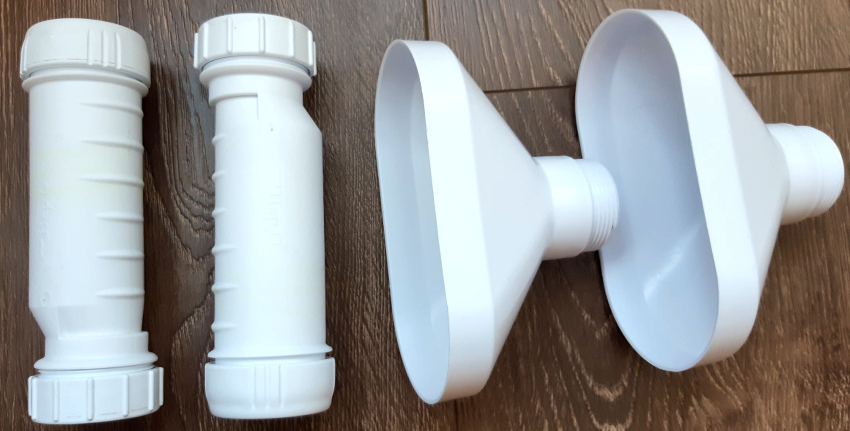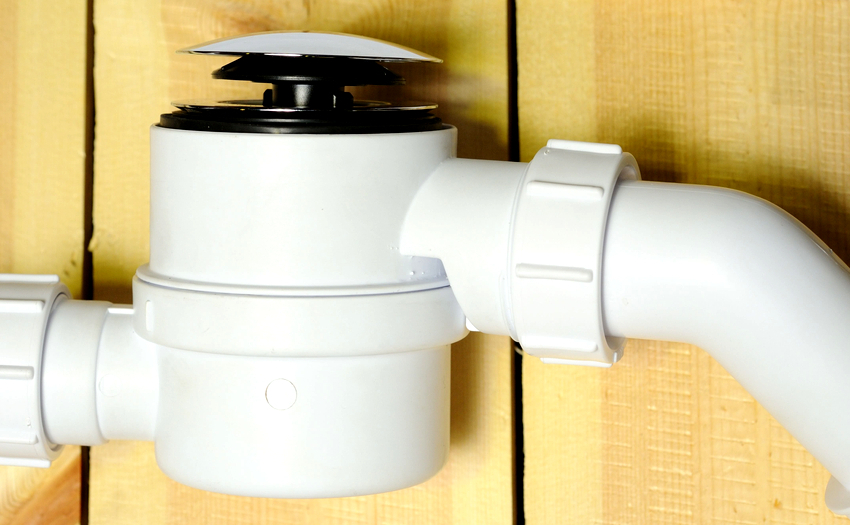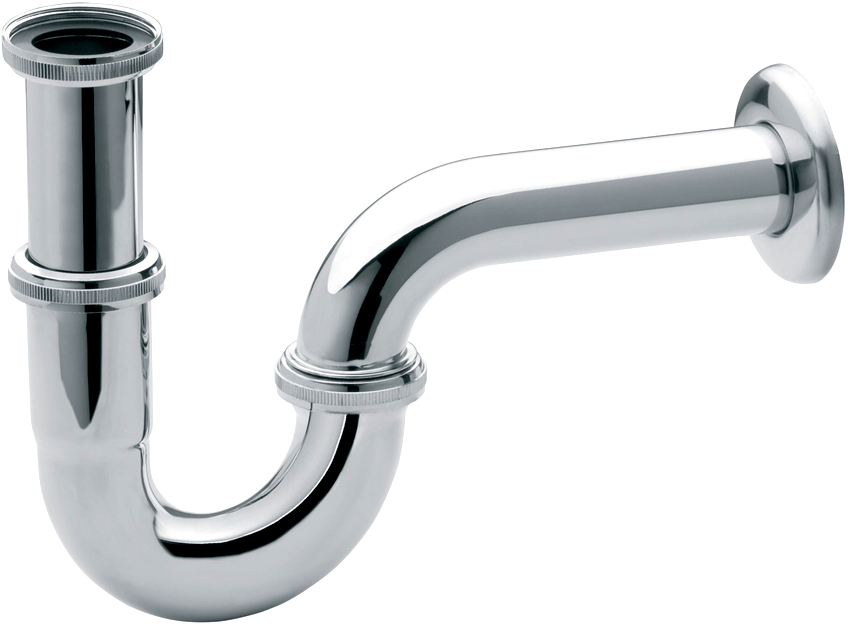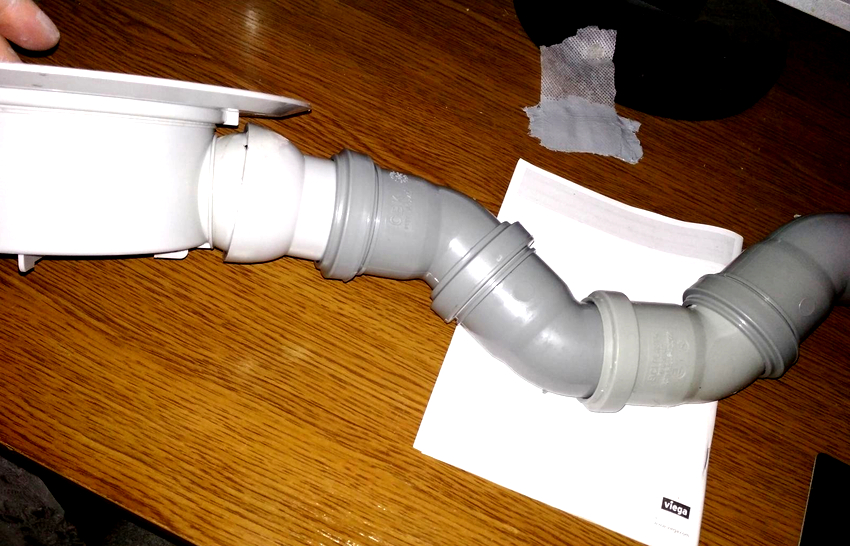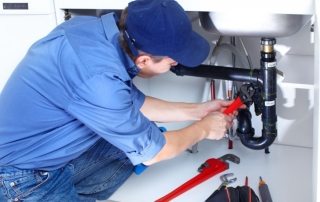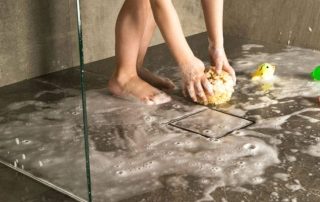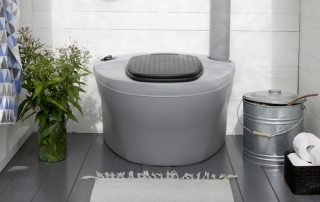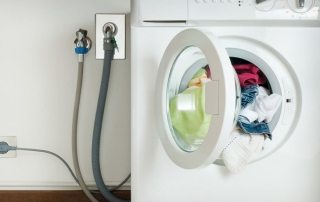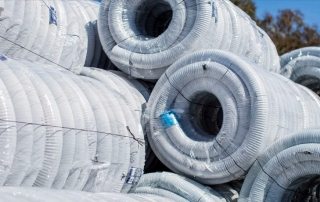Sewer trap is an indispensable element of plumbing equipment. It serves to prevent strong unpleasant odors from entering the room from the drainage system. What is the principle of operation of the device, what are the types of hydraulic locks, how to choose the right product and install it? All answers are contained in this article.
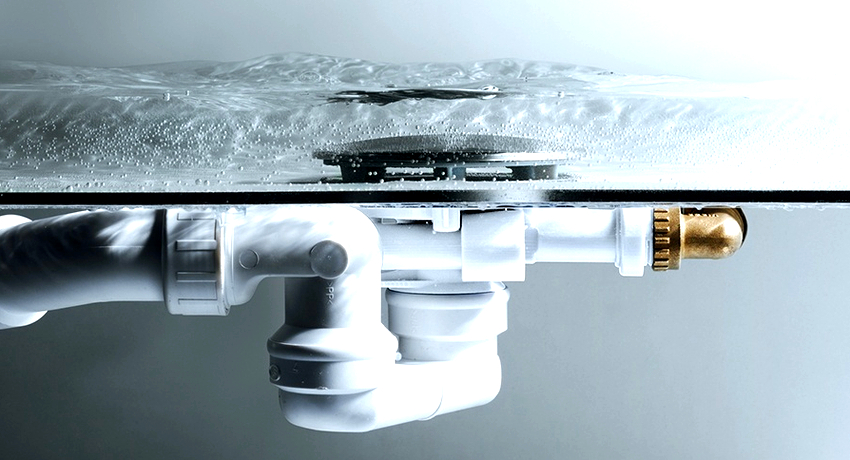
The sewer odor trap is used to prevent the penetration of unpleasant odors into the room from the drainage system
Content [Hide]
- 1 Water trap: this is a must-have element of plumbing equipment
- 2 Varieties of hydraulic valves depending on the design
- 3 Distinctive features of hydraulic bottle closures
- 4 What is a double-turn bathroom odor trap
- 5 Advantages and disadvantages of corrugated hydraulic valves
- 6 Features of the overflow system
- 7 What is a dry siphon for sewage
- 8 Characteristic features of a sewer drain with a water seal
- 9 How to choose the right water seal for the sewage system
- 10 Diy installation sequence of a hydraulic seal for sewage
- 11 How to mount a sewer drain with a water seal
- 12 Possible reasons for the malfunction of the water seal
- 13 How to make a water seal for sewerage with your own hands
Water trap: this is a must-have element of plumbing equipment
The first step is to figure out what a shutter is. The element is represented by a pipe with bends, which has a certain shape. It can be additionally equipped with dynamic or dead-end devices. In the lower knee of the siphon, there is a constant water plug, which, if the system is not used for a long time, can evaporate, which will lead to the penetration of unpleasant odors from the sewer network into the room.
With the active operation of plumbing equipment, the fluid supply is constantly updated, successfully containing foul-smelling substances. When draining, wastewater flows freely through the siphon, which eliminates the possibility of clogging the system.
Important! For the correct functioning of the hydraulic seal, a certain volume of water must be located in its cavity, which is necessary to prevent gas backflow and unpleasant odors.
What is a water seal for? The siphon blocks hydraulic shocks, which significantly reduces the load on sewer pipes and devices. It also protects living quarters from the penetration of unpleasant odors from the drainage system.
A water seal is rarely found inside a particular plumbing device, such as a toilet or urinal. Mostly it is mounted to the device. The residential building does not have a washbasin, bathtub, shower cabin or toilet without a water seal.
Varieties of hydraulic valves depending on the design
Depending on the design features, there are 6 types of hydraulic locks: elbow, bottle, double-turn, corrugated, dry and with an overflow system.
The elbow siphon with a water seal is easily recognizable by its appearance. Its design resembles the Latin letter U. The siphon is made of plastic or metal. The first option is presented by polypropylene products, which are characterized by reliability, simplicity and ease of installation. For the manufacture of metal siphons, cast iron or bronze is used. Today, such models are less common due to their high cost.
Plastic devices can be produced in a disposable design, they do not have the ability to adjust the position of the element. In case of failure, the product is completely dismantled. Other models are made up of building blocks that can move and rotate to adjust the position of the nozzle. The fixing of the parts is carried out by means of overhead plastic nuts and clamps.
The knee has two bends: inlet and outlet. The lower position of the second element is 5-6 cm below the first. More reliable and durable options are presented by the S-shaped design. Cleaning of the product is carried out using a special flexible cable with a brush at the end or manually after disassembling the product.
Such a water seal of the sewage system is characterized by its durability, which ensures a free and easy installation of the system without fear of damage. Elbow siphons are mainly installed on sinks, bathtubs and toilets. There are models equipped with an additional outlet, which makes it possible to simultaneously use a water seal for the washing machine.
Distinctive features of hydraulic bottle closures
Bottle fittings are most often installed in kitchens under sinks. To understand how a water seal works, you should study its design. The product is designed in such a way that food waste particles are trapped, preventing clogging of the system in order to maintain its good performance. At the same time, such a shutter performs the main function, which is to keep unpleasant odors and exclude the possibility of them getting into the room.
The bottle odor trap consists of pipes and an additional bottle-shaped element, which is a kind of container for collecting food waste. This container is located below the level of the drain pipe, this provides free access to the element. The container includes a vertical drain pipe connected to the sink, from its side part there is a branch pipe for connection to the sewer network.
Bottle siphons are made of polypropylene, but in terms of strength they are inferior to knee counterparts. This is due to the fact that the combination of all elements may not withstand the strong pressure of water. However, the bottle siphon is most suitable for use in the kitchen. A positive point also lies in the lower price of a water seal for a 110 mm sewage system, which averages 250 rubles.
For normal operation of the device, it must be periodically cleaned, since food waste remains in the cavity of the container, preventing the free flow of drainage water. To clean the container, it must be removed. For this, the overhead nut is unscrewed, all debris is shaken out of the container. Then you should thoroughly wash the inside of the container with detergents and hot water. After that, the device is installed in its original place. The nut is tightly tightened to prevent water leakage.
Important! Bottle odor traps are capable of trapping an object that accidentally falls into the drain.
What is a double-turn bathroom odor trap
A two-turn siphon is an analogue of a knee outlet, but it differs in a more complex water seal device. The drain pipe of the device is connected to the outlet of the plumbing equipment. In this place, an additional filter grate is installed to trap hair and animal hair. It smoothly turns into an elbow, which connects to another pipe, which is directed to the drain. The last element is located at a slight incline.
How to use the odor trap when cleaning it? For this, some models of double-turn siphons can additionally be equipped with inspection holes, which are tightly closed with plugs, which makes it possible to inspect and clean the cavity of the hydraulic seal from contamination. They are at the bottom of the device. The hole function can be performed by a removable piece of the knee located in the upper part of the device.
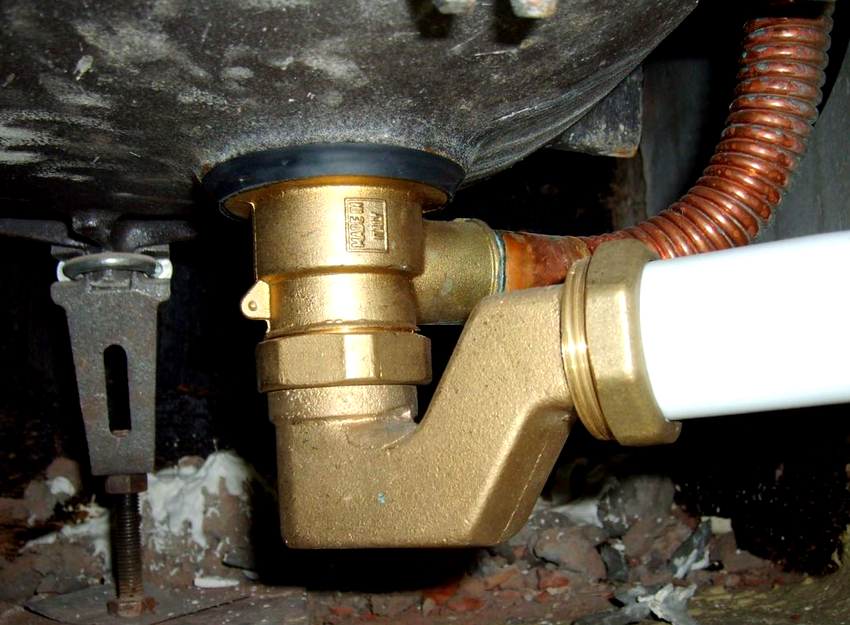
A two-turn odor trap for a bathroom is an analogue of a cranked one, but it is a more complex device
Important! Double-turn valves are predominantly installed in bathrooms.
Double-turn siphons are made of polypropylene. More expensive models of the elite class can be made of brass with a chrome finish. When installing such products, you will need a special tool equipped with soft sponges, which will eliminate the possibility of damaging the mirror surface of the device.
Bottle type hydraulic valves are characterized by strength, reliability and long-term operation. The design is easily adjustable thanks to the movable components. It is easy to install and can be installed even in tight spaces.
Advantages and disadvantages of corrugated hydraulic valves
The corrugated siphon type is presented by a polypropylene modification, which is distinguished by its strength, flexibility and the possibility of installation when arranging sewage systems in small-sized rooms. Due to its plasticity, such a pipe can be located in places where other types of siphon cannot be placed. This is the simplest option, which contains the minimum number of elements that do not need assembly.
The corrugated siphon can be rotated at any angle and directed to the desired direction. This version of a do-it-yourself sewer seal is often installed under the bathroom, since the model fits easily in a cramped place between the floor and the bottom of the tank. One end of the water seal is connected to the drain hole, and the other to the sewer pipe. With the help of a corrugation, you can also organize a drain with a water seal in the bathhouse of a private house.
Despite the many advantages, the corrugated siphon has a single, but significant drawback. The surface of the pipe has ribbed walls, on which debris in the form of hair, soap, sand and other dirt accumulates. When installing such a siphon, a filter with a fine mesh grid should be installed.
Important! If the bellows are not cleaned for a long time, they may lose their strength and elasticity under the influence of excess weight in the form of dirt.
When using a corrugated water seal, you should monitor its condition. Sagging causes debris to build up. The folds will begin to wear out quickly, crack and leak water.
Features of the overflow system
Another type of product is a hydraulic siphon with a water seal for a sink or sink, equipped with an overflow system. The device is equipped with an additional pipe, which eliminates the likelihood of flooding the apartment if it is impossible to drain water into the sewer. This branch pipe is inserted into a specially created hole for it, which is located at the top of the sink or sink.
This siphon prevents flooding, but increases water consumption. If the tap is turned on and the drain is closed, when a certain level is reached, water will flow through the overflow pipe into the sewer. The odor trap with overflow system can be installed in the kitchen or bathroom.
Hydraulic valves with an overflow system are made of plastic or metal. Plastic products are less expensive and highly elastic. Brass-bronze siphons are characterized by strength, durability, installation complexity and high cost.
Important! When choosing a siphon with an overflow, you should pay attention to the throughput of the pipe so that the device will work efficiently in the future.
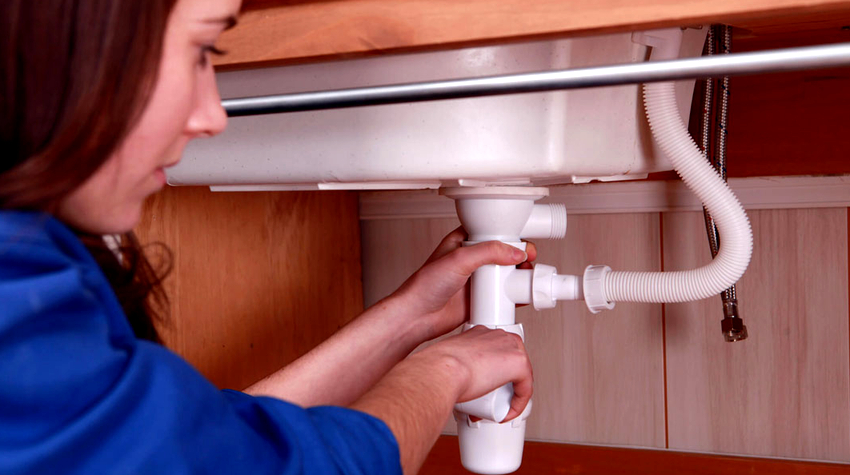
The odor trap for the sink or sink is equipped with an overflow system - an additional pipe, thanks to which the possibility of flooding the apartment is excluded
What is a dry siphon for sewage
The principle of operation and design of a dry water seal for sewerage differ from previous analogues. A non-return valve is installed in the threaded drain pipe, which prevents the return flow of water and the entry of unpleasant odors from the sewer system into the room.
Important! It is advisable to install such water locks only in shower stalls, and in kitchen sinks, they can cause permanent blockages.
A dry odor trap for a shower stall is presented in several varieties. In the membrane version, the opening is closed at the moment of the outflow of the liquid by means of an elastic silicone membrane in the form of a short sleeve. Pendulum siphons, thanks to the curtains, provide quick blocking of access to the hole.
Float models work on the principle of a flush tank. The design is an inverted lightweight glass, the edges of which are immersed in water. The lightweight float is positioned on the water surface. After draining it, sinking, it blocks the drain. In some models, instead of a float, a light ball is installed, which, after the liquid has flowed out, falls into the outer seat, ensuring a tight closure of the drain hole. This option can be made independently when arranging sewer wiring in a bath.
Important! If the sewer lines dry out during the period when they are not in use, the dry seal will prevent an unpleasant odor from entering the room.
Characteristic features of a sewer drain with a water seal
When the drain is carried out from the entire surface of the floor, a sewer drain with a water seal is installed. It is installed in the central part of the floor with a slight slope at the time of construction of the shower stall.
The shower drain with a water seal consists of a receiving funnel, a siphon with a removable grill and a drain with a coupling.The first element is designed to receive water and discharge it into the sewer. It attaches securely to the floor surface.
Related article:
Siphon for sinks with overflow. Subtleties of selection and installation
Varieties of siphons. Nuances when choosing siphons for sinks with overflow. Completion of products, features of correct installation.
The tightness of the connection is ensured by means of a waterproofing membrane. Then the water enters the siphon, which is represented by a small-volume chamber, passing through the upper filter grate and the branch pipe. Then the drain, overflowing through the outlet openings or the edges of the container, moves along the outlet pipe connected to the sewer pipe.
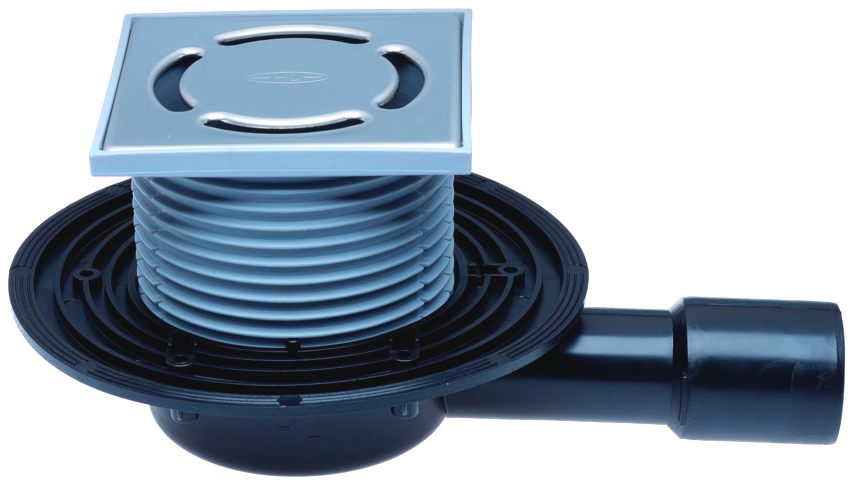
The sewer drain with a water seal consists of a siphon with a removable grate, a receiving funnel and a drain
In terms of design, such a mechanism resembles a bottle-type device. However, the shower tray siphon with odor trap does not have a removable bottom cover, which is used to remove debris. This is due to the fact that the siphon body is hidden in the floor screed. All debris is collected in the inner glass, which can be easily removed from the housing and cleaned with detergent.
Construction and material for the manufacture of a shower drain with a water seal
Sewer drains can be made of plastic or metal. Polymer odor trays for a shower in the floor do not corrode, are easy to install, are characterized by durability and low cost. Metal products can be made of cast iron or steel. The first option is characterized by high throughput and durability. However, due to its significant weight, it is laborious to install. Cast iron drains are suitable for swimming pools, toilets and laboratory rooms.
Stainless steel drains are lightweight, reliable, durable and easy to install. It is customary to install them in medical and research organizations, because the devices meet the requirements of sanitary standards. The receiving grille can be circular, square or rectangular.
The sewer drain with a dry odor trap has a horizontal or vertical design. The first option, whose height is 6-10 cm, is often used for an apartment or private house. It is also installed in confined spaces.
The vertical drain has a height of 15-18 cm, is characterized by a high flow capacity and is mainly used for shower stalls. A ladder with a drainage system with a diameter of 50 mm is installed in apartments and houses, and a water seal for sewage 110 mm in public premises.
How to choose the right water seal for the sewage system
When choosing a water seal for the sewage system, the price of which is in the range of 300-600 rubles, the following factors should be taken into account:
- dimensions of the assembled siphon;
- features of this type of device;
- material for the manufacture of pipes and fasteners;
- number of drains and possible additional connections;
- the level of protection against blockages;
- the presence or absence of overflow.
The shutter type is selected based on the installation location. For the kitchen sink, the best solution would be a bottle design equipped with a container for collecting food waste. For a bath, it is most convenient to mount a corrugated siphon, which can be located even in the most cramped conditions.
The version of the shower siphon is selected taking into account the frequency of its use. If it will be used rarely, a dry odor seal for a bath or shower should be installed, which, even when the water dries, will not let foreign odors into the room.
The number of inlets in the siphon must correspond to the number of drains for which the given odor trap is intended. An important criterion is the diameter of the neck of the device. For the sink and washbasin, it can be minimal, and for the toilet - the largest. The diameter of the outlet pipe is also taken into account when connected to a sewer pipe. For sinks and washbasins, a 50 mm drain seal is sufficient. For a toilet bowl, this parameter should be at least 100 mm.
Material for the manufacture of a hydraulic seal
The reliability and durability of the device depend on the material of manufacture. Traditionally, steam locks for baths, bathrooms and kitchens were made of cast iron, due to which they were characterized by strength, resistance to aggressive environments and a long service life. The disadvantages of products include the presence of an internal rough surface, which tends to retain various contaminants. It is ideal for industrial construction.
Most modern models of hydraulic seals are made of polypropylene, as a result of which they have a low cost. The devices are characterized by strength, reliability, chemical inertness, lack of tendency to accumulate contaminants in the cavity (due to the smooth inner surface).
Premium dry odor traps are made of brass or bronze with a nickel plated finish, which gives the products an aesthetic appearance. Such valves are distinguished by a long period of reliable operation. Stainless steel siphons are in demand in hospitals and children's institutions. Such devices are well cleaned and disinfected, which does not affect their durability.
Diy installation sequence of a hydraulic seal for sewage
Installing a water seal for a sewage system in a bath, bathroom or kitchen is a simple undertaking that you can do yourself without having certain skills. Under the washbasin or sink, the installation process is quite simple, and under the bathroom it is more laborious, due to the inconvenient location of the drain system.
Important! Any type of siphon can be purchased complete with all the components at a plumbing store.
Consider installing a do-it-yourself water seal for a 110 mm bottle-type sewage system. The set includes a siphon, corrugated pipe, overflow design elements and fasteners. The first step is to equip an overflow hole. To do this, an elastic gasket is inserted into it, which is fixed with a silicone sealant. Then a chrome-plated decorative element with a stem is screwed onto which a lamb is attached.
At the next stage, fittings are installed to decorate the drain hole in the bathtub, sink or washbasin. A long fixing screw is screwed into it, which fixes the siphon. First, it is twisted by hand, then clamped with a key. A rubber gasket is put on the plastic outlet. Next, insert the knee bolt. Finally, tighten the plastic outer nut. The water seal is connected to the sewer pipe by means of a polypropylene pipe.
After the installation is complete, the system is tested. For this, the device is filled with water. All elements of the system are inspected for leaks.
How to mount a sewer drain with a water seal
Installing a sewer drain with a dry water seal is a very responsible and time-consuming process. The correctness of work performance directly determines the level of high-quality and durable operation.
At the first stage, the floor in the shower or bath room is lifted, which should have a slight slope towards the ladder, which will contribute to the spontaneous drainage of water from the horizontal surface.
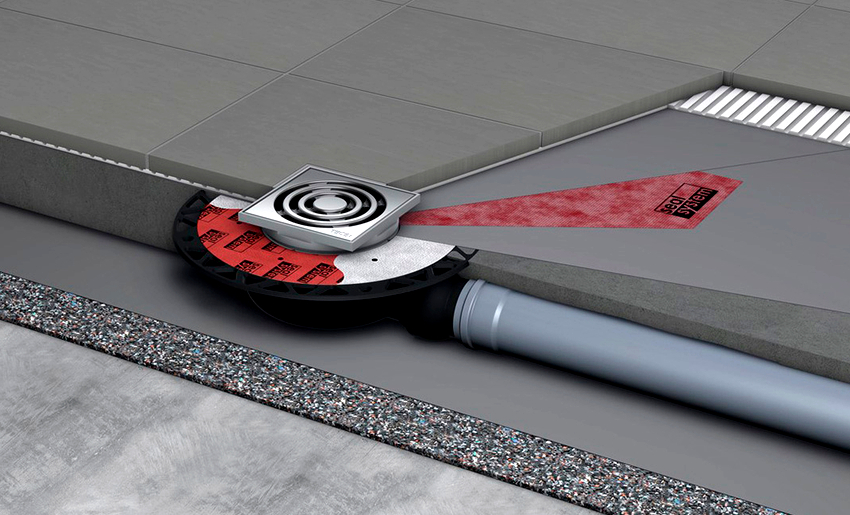
The sewer drain is installed according to the instructions - thermal insulation, waterproofing, cement screed and floor tiles are laid on the floor
The sewer drain is installed according to the instructions that come with the device. A heat-insulating material is laid on the surface of the floor, at the same time playing the role of sound insulation, which contributes to the quiet drainage of water from the plumbing fixture into the sewer system. Styrofoam is suitable for this. Then a layer of waterproofing is laid. For this, you can use a roll material with a membrane structure or a coating mixture.
Next, a cement screed is made, the thickness of which is selected taking into account the height of the ladder and the thickness of the tile. Floor tiles are laid on top with an adhesive solution.
Important! The water seal grille must be flush with the tiles.
Possible reasons for the malfunction of the water seal
The hydraulic valve is a simple product in design, which consists of a minimum number of simple elements. Therefore, the failure of the siphon is extremely rare. In this case, situations may arise that negatively affect its normal functioning.
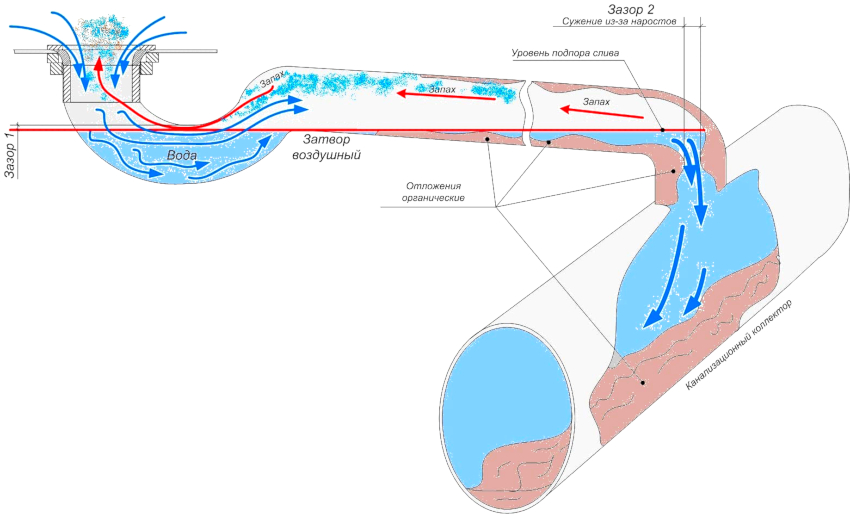
Non-observance of slopes and violation of the sequence of assembly of the hydraulic seal can negatively affect its operation.
Failure of the device can occur as a result of a sharp drop in pressure in the pipes, a malfunction of the sewer network, depressurization of drain pipes, which is possible as a result of mechanical damage or improper connection.
If a riser is clogged in a multi-storey building on the upper floors, when large volumes of water are released, a vacuum is formed in the pipe, as a result of which water is attracted from the water seal. This causes unpleasant odors to appear. In this case, the question arises of how to eliminate the airlock in the sewer. You can eliminate the problem by cleaning the riser or installing a vacuum valve at its end. Dry valves often begin to malfunction as a result of clogging of the descending float or closing diaphragm.
Incorrect installation will also adversely affect the operation of the device. The reason may lie in non-observance of slopes, disruption of the assembly sequence of system elements, spontaneous straightening of the corrugation.
Important! If the siphon is rather old, it may no longer cope with its main function of protecting the room from the penetration of unpleasant odors. In this case, it will be necessary to disinfect the well with a water seal or replace the device with a new element.
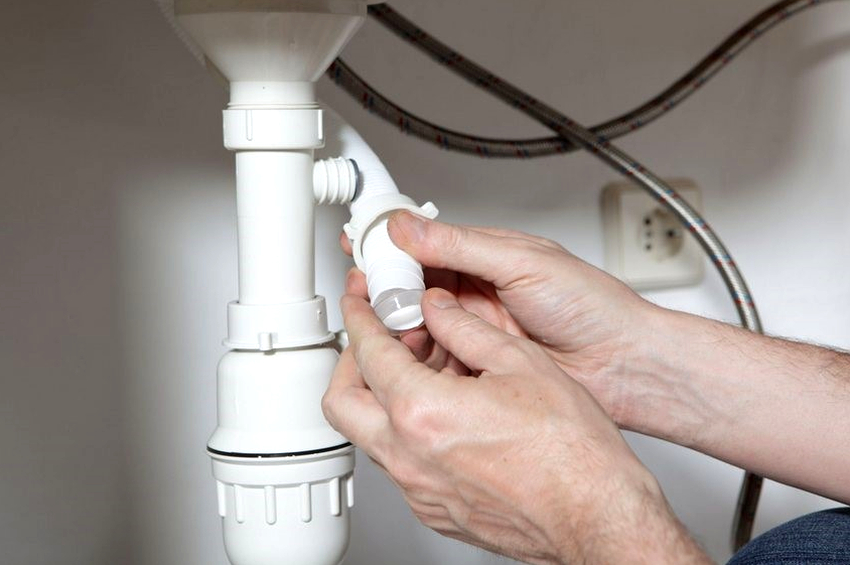
If the siphon is old, it may not cope with its task, it is necessary to replace the water seal with a new one
If there is a sewage odor in the room, it is necessary to check the functionality of the water seal. You should pay attention to the water level in the toilet, which should be the same for every flush. In the bathroom and kitchen, the check can be done with a flame. To do this, a match is brought as close to the sink as possible. The absence of a flame will indicate normal operation of the device.
If the flame ripples, turn on the water for a minute, and then check the operation of the device again with a flame. If it still wobbles, the siphon is faulty.
How to make a water seal for sewerage with your own hands
How to make a water seal with your own hands? The simplest siphon design is a self-made knee hydraulic valve. For its manufacture, you will need a plastic pipe, which is selected according to the diameter of the drain. It should be bent into a U-shape.Next, a homemade siphon must be attached to the top of the sewer pipe, fixing it with couplings.
The diameter of the hydraulic seal may not match the size of the branch pipe at the point of connection to the sewer pipe. In this case, you can use an adapter in the form of a plastic ring having two different diameters, one of which must correspond to the size of the water seal, and the second to the parameters of the sewer drain. For a secure connection, the O-ring should be coated with silicone sealant.
Important! The bend of the siphon should be 50-70 mm below the drain hole.
To create a dry seal, you can use a tennis ball that is slightly larger than the pipe. Then the camera in which it will be located is executed. It connects to the sewer pipe. The ball will float while there is a water plug in the shutter. After the water has completely disappeared, the ball, like a float, will drop to the bottom of the chamber and block the drain pipe.
This dry odor trap can be used in frosty weather. If the ball freezes to the pipe, the problem can be solved by treating the fixture with hot water.
A water trap is an important device for the comfortable and reliable operation of plumbing fixtures. It prevents unpleasant odors from the drainage system from entering the room. The choice of a specific type of siphon depends on the place of installation of the device, which can be easily installed by yourself.


